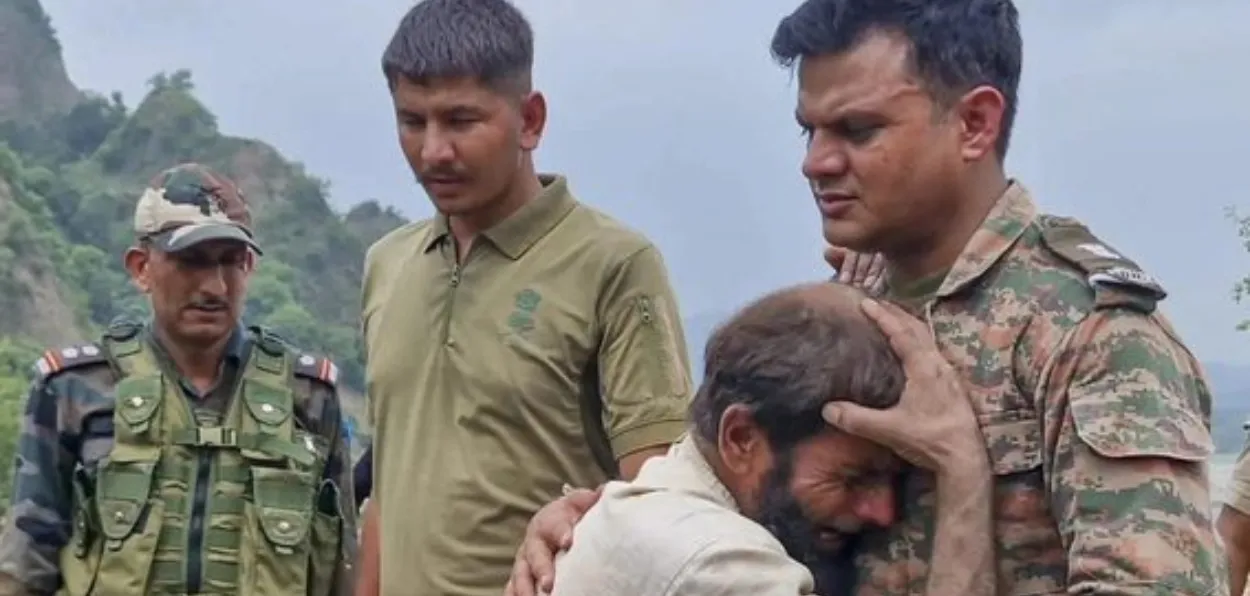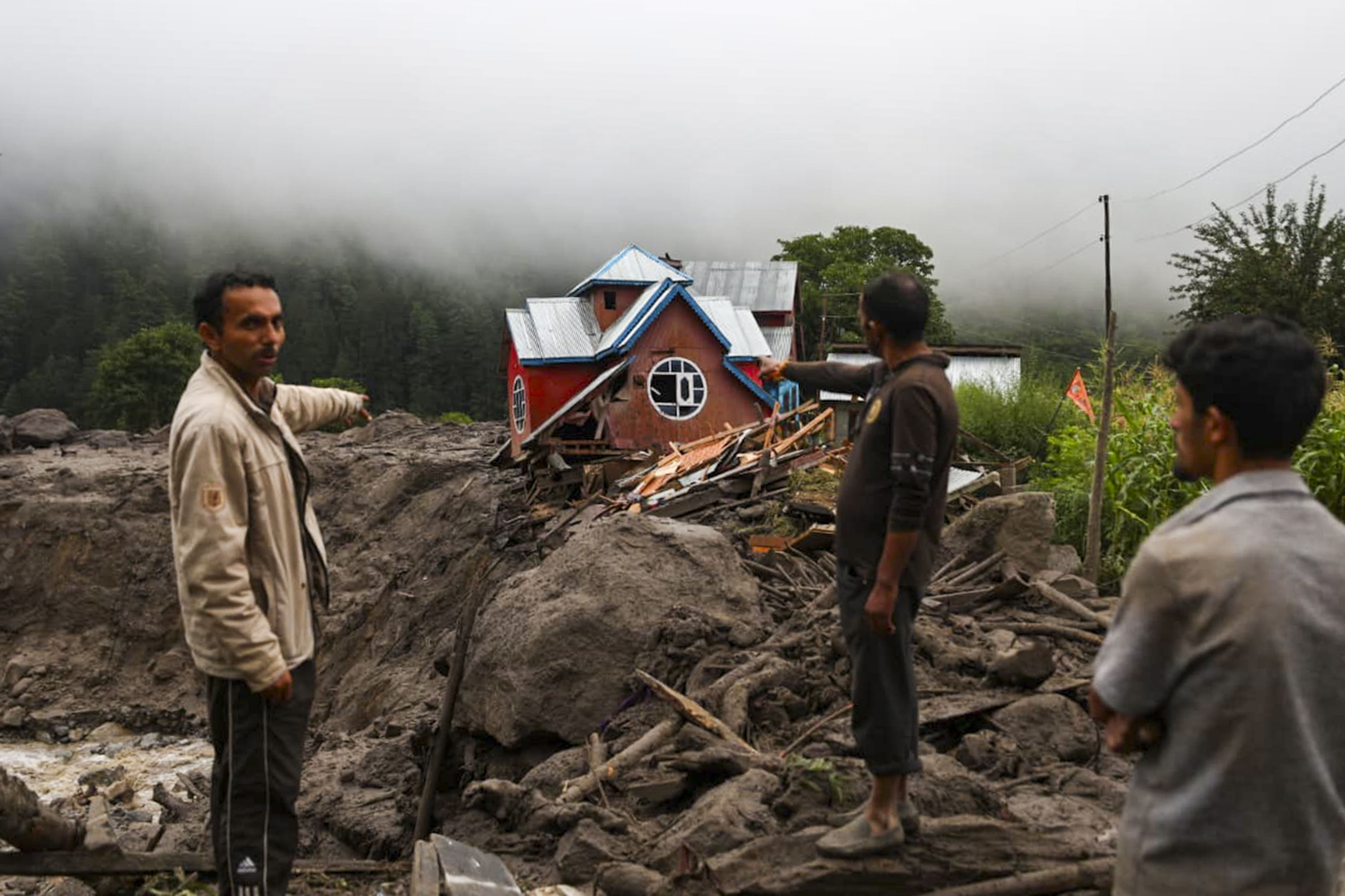
Danish Ali/Srinagar
On the morning of August 14, the village of Chisoti in Padder, Kishtwar —a century-old settlement and the last motorable stop before the annual Machail Mata Yatra — was humming with pilgrims and the clatter of community kitchens.
By afternoon, a wall of water and boulders came crashing down, reducing everything in its path to rubble; the village echoes with a deafening silence followed by desperate cries for help.
The cloudburst has so far claimed more than 65 lives, including two priests, and with no hope for 70-odd missing and probably washed down, and over 100 injured.

A villager looks around his devastated abode in Chisoti
Makeshift shelters, temples, and roadside stalls were swept into the Chenab’s furious waters.
“We ran, but the water ran faster,” say the survivours.
Eyewitnesses recall scenes of utter chaos as nearly 2,500 pilgrims scrambled for safety. “My mother and sister were selling rotis when the floods came. Both were swept away,” said 22-year-old Sawant Singh, pointing towards the remains of his partially destroyed house.
For many families like his, the pilgrimage that once brought livelihood now carries the weight of irreparable loss.
Umar Iqbal, 37, from Doda, who joined the rescue efforts, described the horror: “We saw 63 bodies being pulled out. I have never seen such destruction in my life. This village stood for more than 100 years, but within minutes, it turned into debris.”
Hospitals Overflow with Grief
At Government Medical College, Jammu Hospital, the corridors overflow with patients, relatives, and volunteers.

Local villagers speaking to Chief Minister Omar Abdullah
Doctors confirmed that 75 people who were brought from Chisoti were admitted there, one of whom later succumbed, while four are in critical condition.
On Sunday, the mortuary received 11 bodies and one body part, which were later handed over to grieving families after medical formalities.
“Scenes no one should ever have to witness”
Dr. Mujtaba Ahmed, 43, from Kishtwar, said, “This village is so remote, yet the entire district is drowned in sorrow.”
“We don’t even have accurate data on how many people are still missing. Every day, locals head out to join the rescue operations. The Army is doing commendable work; they built a bridge in a single day. We feel proud of our soldiers.”
#JammuAndKashmir: Indian Army constructs temporary bridge over Chishoti Nala to ensure the smooth movement of people, after cloudburst in Kishtwar.#IndianArmy #KishtwarCloudburst pic.twitter.com/035Kz83vfJ
— All India Radio News (@airnewsalerts) August 18, 2025
Army building a bridge to the devastated village in Kishtwar
He still cannot come to terms with the shock of what he saw. “When I reached Chisoti, I was shocked. Seeing dead bodies lying in the debris was unbearable. Many bodies were mutilated so badly that it was difficult to identify them. It broke my heart to see children’s innocent faces crushed under the weight of boulders and mud. I saw a brother searching desperately for his sister’s body, and a father digging through rubble for his child. These are scenes no one should ever have to witness.”
He said he could not stay there for long as he was overwhelmed with emotions and shock. “ The cries of families tore through me.”
The rescue operations, he added, are far from over. “The weather turned bad today, forcing teams to pause. This is not the work of a single day; it will take many more days to recover all those who are missing.”
Faith Meets Humanity
Amid the wreckage, stories of solidarity and compassion have shone through. Volunteer groups, particularly Ababeel and Furkan Welfare Trust, and Seva Bharti became lifelines. Their ambulances ferried survivors, volunteers donated blood, and community kitchens were set up outside hospitals to serve food to survivors and their attendants.
Sewa Bharti Unit working in Chashoti Padder Kishtwar area #cloudbrust area #rss sawimsevak on duty @RSSorg @friendsofrss @AskAnshul @AdityaRajKaul @_vatsalasingh @AnkurSharma_Adv @BattaKashmiri @Devansh_IAS pic.twitter.com/ZhmL2R09AT
— Kishtwar Heroes (@kishtwarheroes) August 18, 2025
“We placed men in hospitals to arrange food and blood for the injured,” said Bashir Ahmad of Ababeel, who travelled over 100 km from Daedtel.
For families arriving from faraway villages, Ababeel volunteers who carried bodies, arranged shrouds, and helped with last rites.
Stranded passengers at Chisoti Padder are being evacuated with the support of seven ambulances of #Ababeel for their immediate rescue and relief#kishtwar__cloud_brust😱@ABABEEL02 pic.twitter.com/cR2BuVt3lg
— Bilal Raina🇮🇳 (@BilalRaina17) August 16, 2025
The scale of the disaster mobilised a massive response. The Army’s 17 Rashtriya Rifles, Police, CRPF, CISF, SDRF, and NDRF teams braved treacherous terrain to rescue nearly 100 people.
People are coming our with stories of local heroes who rescued many people:
The boy from Paddar who worked Day night in Rescue Operation at Chishoti Paddar (kishtwar)@Impaddri
— Deepak Thakur 🇮🇳 (@Deepinhimalayas) August 19, 2025
Hats off for your dedication.
You are the live example of Humanity
Many many salute to you pic.twitter.com/PjBUndOU2w
Local officials, including ARTO Kishtwar and Tasleem, were praised for working around the clock. “The administration is on its toes,” Umar Iqbal noted. “They have done a wonderful job alongside NGOs.”
ALSO READ: Arif Rashid worked 3 days without pause; saved at least 79 lives
The tragedy has cast a long shadow on the Machail Mata Yatra, a pilgrimage that takes devotees to the hill shrine of the Goddess and binds the local communities.
